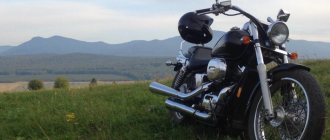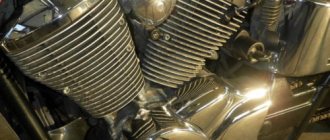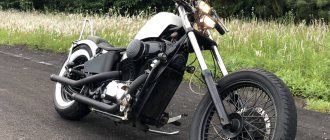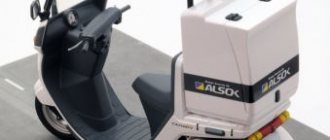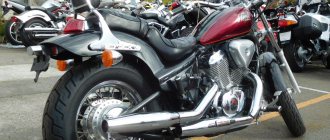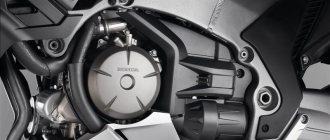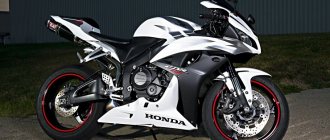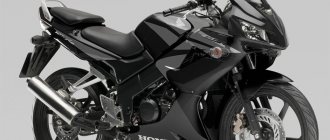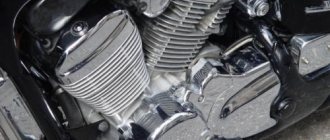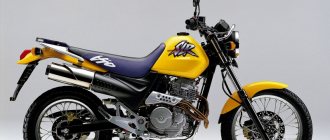- Honda motorcycle model
The Honda Shadow 750 series of cruisers begins its history in 1983 with the introduction of the Honda NV750 Custom model, which was available in the North American and Japanese markets. In 1986, the motorcycle changed its name to Shadow 750, being updated technically and visually. The model of that time was quite heavily boosted (which is typical for all Japanese cruisers of those years), producing up to 66 hp. power. These versions are present at Japanese auctions, but due to their age, there are not many of them.
In 1997, the first version entered the market with the name Honda VT750 Shadow in the American Classic Edition (ACE) modification, which began the rapid growth of the model’s popularity. The modification featured classic American features with deep fenders, wide spoked wheels and chain drive. At the same time, an internal Japanese modification was released - the Honda Shadow 400.
In 2000, the Shadow 750 line was replenished with a new modification - the Honda VT750DC Shadow Spirit. In Japan it was sold under the name Slasher, and in Europe - Black Widow. The model featured short fenders, a thin 19′ front wheel and a smaller fuel tank (13 liters instead of 14 liters in the ACE). Otherwise, the motorcycle was equipped with the same engine, chain drive and two carburetors.
In 2003, the Honda VT750C Shadow ACE modification finally left the market, giving way to the new Honda VT750C Aero. The new model received many technical changes regarding ergonomics, overall dimensions, front suspension, engine, intake system (using one carburetor instead of two) and drive (instead of a chain, the model received a cardan and changed gearbox ratios).
In 2007, the Honda VT750DC Shadow Spirit (Slasher, Black Widow) modification leaves the market, giving way to the new Honda VT750C2 Shadow Spirit. The model visually resembles the previous modification, but is equipped with a 21′ front wheel, electronic fuel injection (since 2008, 1 carburetor in 2007), cardan drive and a 14-liter tank. The Aero modification gets an injector.
In 2009, another modification appeared - the Honda VT750C2B Phantom. In some countries it was sold under the name Black Spirit. Despite the similarity of the name with the Honda VT750C2 Shadow Spirit, the Phantom modification is not related to it, but is a version of the Aero in black, straight handlebars and short fenders. The Aero modification includes versions with ABS.
In 2010, another modification was introduced - the Honda VT750RS Shadow. In the Japanese market it was sold as the Honda VT750S. Visually reminiscent of the classic Honda VRX400. The Shadow 750 differs from the entire line in its shortened wheelbase, increased seat height, increased ground clearance, practically the lowest curb weight (second only to the NV750 Custom), a 10-liter fuel tank and a chain drive.
In 2013, the RS modification leaves the market, and the Honda VT750C2 Shadow Spirit receives a version with ABS (designated VT750C2S). 2015 was the last year of production of the Honda VT750C2 Shadow Spirit modification.
Currently, only the Aero and Phantom versions are present in the production line.
History of the Honda Shadow 750
The Honda Shadow 750 is a successful representative of classic mid-power cruisers.
The release of the line continues.
Over its 30-year history, the motorcycle has repeatedly changed its filling - a chain for a cardan, a carburetor for an injector, a gearbox from 5 to 6 stages and much more.
But unlike other similar situations, when the updated model is called a new generation, Shadow had modifications. It’s interesting that the contents of each new version were developed from scratch, and not always using the latest solutions in the world of motorcycle fashion. Sometimes developers deliberately took a step back.
Model history
Initially, the Shadow line, which the Japanese company offered to Americans, consisted of only two models - the Honda Shadow VT500C and Shadow VT750C.
These motorcycles appeared in 1983. The first of them was equipped with a 500 cc V-twin OHC engine, the second had a volume of 750 cc. cm.
This engine was also V-shaped, V-Twin SOHC.
The following year, after the Honda Shadow appeared on the market, American legislation increased duties on imported motorcycles larger than 700 cc.
As a result, production of the Shadow VT 750C model “stalled” for many years.
At the same time, the Shadow line itself expanded, and quite significantly.
During production, models with engines from 400 to 1100 cc were produced.
But the Shadow model with a 750 cc engine was remembered only in 2000, but this model was already aimed at the European consumer.
The Honda VT 750 Shadow, released in 1983, had the classic American cruiser style. The model was produced in two colors: black and caramel red.
Although, the red color is only a convention, since only the tank and side glove compartments were red on the motorcycle. The engine and frame were painted black.
Many elements of the motorcycle were chrome-plated: the front fork and fender, dashboard, headlight, exhaust pipes.
The engine of the motorcycle was equipped with water cooling, and the gas distribution mechanism implied the presence of three valves for each cylinder. The Shadow VT750C had a 6-speed gearbox, and the rear wheel was driven by a cardan.
In 2000, the successor to the first Shadow VT750C was a model with a slightly different name - Honda VT750DC Black Widow, aka “Black Widow”.
Although the name is different, the “widow” is still a Shadow VT750C, but with a slightly modified appearance. This motorcycle was already more like a “chopper”.
In 2007, another model with 750 cc engines appeared in the line, but the Shadow prefix was added to the name of these models.
First came the VT750DC Shadow Spirit, followed by the VT750DC Shadow Black Spirit. These models are still in production.
The differences from the first 750 cc Shadow among contemporaries mainly concern the appearance, although there are also changes in the technical part.
Now these motorcycles are already 5-speed, the power system has also changed - carburetors have been replaced with an electronic injection system.
But in general, the concept of the motorcycle itself remained the same - many chrome parts, including the engine, low seating, drop-shaped tank.
And only the VT750DC Shadow Black Spirit model is distinguished by almost no chrome, it is almost all black.
Specifications
The engine size was changed only once, in 1997 , but the settings of individual components, the number of cylinders, the compression ratio, and power changed from modification to modification. In some versions, the injector was even replaced with a carburetor . But it was based on a 2-cylinder, 4-stroke engine with a V-shaped pistons . The angle between them was changed once - in 1997 from 45 to 520.
The engine is quite economical, works in any weather, and is not even afraid of heat.
- Displacement - 745 cm³ (since 1997), 749 - early releases.
- Power - 44 hp (up to 65 hp - early releases).
- Number of valves - 6 (3 per cylinder).
- Cylinders - 2.
- Cooling is liquid.
- Fuel supply - Keihin 34 mm carburetor, PGM-Fi injector (since 2007).
- Ignition is digital, transistor.
- Start - electric starter.
- Fuel tank - 14 l.
The ignition switch is located under the fuel tank, which is an interesting feature of the model.
of hydraulic compensators in the engine , so the user does not need to adjust the valves.
Transmission and clutch
Motorcycles of early assemblies were equipped with a 6-speed gearbox.
But in 1997, it was rebuilt, retuned, and the gears were placed across the entire rev range. This box began to be used on all modifications.
No less interesting is the story of the main drive. Initially, the motorcycle had a cardan, which was abandoned in 1997.
The cardan transmission definitely reduced the ongoing costs of maintaining the motorcycle.
- Honda VT750 Shadow ACE model came with a chain drive .
- In 2003, ACE was replaced by Aero. In addition to many technological innovations used in the modification, the cardan .
- The 2010 model year models again have a chain.
The only part of the chassis that was not changed was the clutch. From the first assemblies, the standard principle was used.
- Multi-disc, oil bath.
- Power transmission is a cable.
Brakes
Front brakes.
Rear brakes.
With the exception of the very first builds in 1983, which had two discs at the front, the motorcycle has a front single-disc brake and a rear drum brake.
Front: brakes:
- number of disks - 1;
- diameter - 296 mm;
- support - 2-piston.
Rear brakes:
- drum
In 2010, Honda is carrying out a massive modernization of both new developments and those already on the assembly line. The rear axle receives disc brakes (the parameters are the same as the front ones), as well as ABS.
To avoid causing even more confusion with names, new models are not renamed.
Conclusion
In its class, the Honda Shadow 750 can be called one of the best. In terms of weight and controllability, it is close to a “four hundred”, and in terms of dynamics – to a “liter”. This balance, coupled with phenomenal reliability, an affordable price and a ton of tuning, ensured the model such a long life. This chopper is equally suitable for driving around the city and for long trips. With timely maintenance, it will serve the owner for years without problems or breakdowns, for which it is valued in many countries around the world, and its technical characteristics are sufficient for any purpose.
Specifications
| Power: | 42 – 45 HP |
| Torque: | 59 – 69 Nm |
| Engine type (cylinder arrangement): | 2-cylinder, 4-stroke, V-shaped |
| Number of cylinders: | 2 |
| Engine capacity: | 745 cm3 |
| Cooling type: | Liquid |
| Transmission: | 5 |
| Drive unit: | chain/cardan (depending on version) |
| Frame: | Steel |
| Weight: | 238 kg |
| Tank capacity: | 14 l. |
| Maximum speed: | 160 – 180 km/h |
| Wheelbase: | 1640 mm |
Driving performance
The device accelerates quite confidently, and easily outpaces most ordinary automobiles up to a hundred. but then it starts to deflate.
Introducing the new model, the developers indicated the main parameters - speed, acceleration to hundreds, fuel consumption; according to users, these figures directly depended on the weight of the motorcycle.
Thus, the Shadow RS model launched in 2010, with reduced weight, a chain and a 10-liter tank, was supposed to show 177 km/h.
ACE - the first-born of the new one (more weight, larger tank) - 159 km/h .
Acceleration from standstill to 100 km/h was also smooth. From 7.3 s on Aero to 6.8 s on ACE.
At the same time, consumption depended on the type of driving, but with an average cruiser it did not rise more than 4 liters .
Dimensions and weight
The geometric parameters of the Honda Shadow 750 have changed many times.
Because Shadow 750 is not the only model, but a whole series of modifications, and their external parameters also differ.
- Dry weight started from 211 (in 1983) to 246 (2018) kg.
- Equipped, with fully filled tanks - 225 (1983) to 263 (2018) kg.
And the dimensions also changed;
- The length changed 8 times from 2191 (NV750 Custom) to 2511 (Aero).
- Width - 10 times from 860 (NV750 Custom) to 940 (Aero).
- Height - 10 times from 1199 (NV750 Custom) to 1091 (Aero).
- Seat height - 760 (NV750 Custom) to 660 (Aero).
It is worth noting that Aero was developed in 2003; subsequent models had smaller dimensions. The exception is seat height. All earlier and later developments were larger.
For whom is it intended?
The motorcycle can be comfortable for people of different heights, depending on the modification.
Despite such variations in size, the engineers did not forget about the user.
Both a short Japanese and a giant European could find a model suitable for themselves.
The bike cannot be called universal, since they chose different modifications, but the developers managed to please everyone.
In this article, I want to practice and set myself a difficult mental challenge - to try to describe my impressions from the outside for those who have not sat or driven such a motorcycle. Despite the fact that, in general, I haven’t driven other classes of motorcycles—Ebrik, Java and scooters don’t count. Initially, this text was written for another resource and for people less experienced in the topic. Now, after running it in, I’m posting it here for the sake of reviews and criticism. What is a big cruiser with a V-twin as a motorcycle in general?
Big?
Yes, yes, I know that I don’t have the biggest, not the heaviest, not the most powerful, not the most motorcycle to lean on. It's just a solid cruiser, and that's what I'll rely on. I’m not describing a Harley here or an 8-liter BOSS HOSS, but my motorcycle.
(this is BOSS HOSS)
Cruiser?
Cruiser, or cruiser (eng. cruiser) is a type of motorcycle.
The name comes from the English word cruise/cruising, which means “to cruise”, “to follow a course”, “to travel with the purpose of traveling”. It is characterized by a low seat, an upright seating position, often far forward footrests, an abundance of chrome and significant weight. The cruiser is not designed for fast driving or off-road driving; its engine usually does not have high power, but it has light and comfortable handling, high torque at low speeds and an appropriately “menacing” sound.
So, a big cruiser is a motorcycle for the road. Moreover, for roads in the most romantic sense of this meaning. You can experience the pleasure of owning it as such, you can enjoy the sound of the engine, the luggage space, the chrome, in a word, anything, but the further the road goes from the “romantic ideal”, the less you will be happy with this motorcycle. What is the ideal of the road? This is easy to explain with a picture:
I couldn’t find a better one, but I think you understand me anyway. Nevertheless, I will say - a big cruiser is (what a surprise) a motorcycle for a long road, for a highway that reaches the horizon. Although even this is not always true. And don't think I'm talking about American highways. No, we also have excellent roads:
(M-4 Don highway)
Although yes, for some reason, even when riding around the Moscow region, I’m already starting to want a tourenduro... I digress. But as soon as the quality of the road becomes poor (and we have a lot of such roads outside federal highways), or you find yourself in heavy traffic (I live in Moscow, for me heavy traffic is the norm of life) - you will not experience the pleasure of the trip.
V-Twin?
In case you don't know what a V-Twin is, I have a simplified gif of it. I actually have a lot of such schemes 
And there's a catch with the V-Twin. Actually, I can roughly divide two-cylinder V-shaped engines into 3 humorous types:
- true believers
- unfaithful
- household
The true believers are Harley & Davidson Co.
Every Harley owner will tell you this. Just kidding, not everyone. It’s worth distinguishing between Harley owners and Harley riders, and in general, we don’t give in to stereotypes, it makes our brains sour. But, one way or another, I called the Harlev version of the V-Twin “correct” - shaking and vibrating. But excuse me, what if I like the image of such motorcycles, but don’t like sitting on a vibrator? The cunning Japanese took it and built such a unit. Moreover, there are countless modifications to the line. Judge for yourself: Shadow ACE; Shadow ACE Tourer; Shadow Saber; Shadow Spirit; Shadow Phantom; Shadow Slasher; just Shadow; Black Widow; Steed finally - and even then I might not remember everyone. Actually, not only Shadow and not only Honda - there are a lot of models. But we're talking mostly about mine. By the way, Steed 400 and 600 and Shadow 400 and 600 are generally slightly different - and this happened because Steed was sealed for the domestic market, and Shadovka for the external market. And there’s practically only one motorcycle.
Depending on the modification, the Shadovka may be more or less similar in engine to a Harley (read - more or less shaking, with maximum torque at higher or lower speeds). But it’s just similar - water cooling is a useful thing. Especially in a city like Moscow. And if only there was water cooling! The Japanese decided not to worry - there was plenty of time and stuck... a driveshaft in my back door, just look:
The cunning Japanese have done a lot of other things.
Previously, rebels did hard tails - this is when there is simply no rear pendulum and shock absorber. Then, when they got their butts back, they started installing a soft tail - this is when the frame is welded so that it looks like there is a hard tail, and the shock absorber is hidden inside the frame, under the seat. And if this is still the case in Steed (by the way, it is much closer to a chopper than the others), then in Shadow they simply didn’t bother and installed 2 shock absorbers on the outside. And with the Saber they went even further - somehow it was accepted that the air filter on the V-Twin was on the side. But the Japanese took the Shadow Saber and put it in the free space under the seat. Compare:
On the one hand, it seems wrong again.
On the other hand, it’s more convenient. And, well, household ones - in general, a V-shaped 2-cylinder engine does not have to be a low-speed engine. Such engines have easily taken root in the Afica Twin and Transalp and in the same Suzuki V-storm. And not only there, but we are not talking about them. Okay, my first question to myself was scattered to smithereens, and we went to compare everything and everyone!
Landing
In general, landing is an individual concept.
For some reason, it turned out to be terribly uncomfortable for me to sit on the Valkyrie 1500. However, the riding position on this motorcycle is comfortable. It should be convenient, if we remember that our task is to travel far and the goal is to travel rather than “get there faster.” For a person who has never sat on such a motorcycle, I can suggest that you sit in a regular office or computer chair, stretch your legs horizontally, lower them to the floor and slightly pull them towards you so that your feet completely touch the floor, but it does not seem that you are pulling somewhere with your legs . That's basically all. As for the width of the steering wheel... people often change the steering wheel to suit themselves (as well as the seat), but the general principle is this: imagine that cute twins with size 4 are standing close to each other in front of you. Take them by the extreme si, in general they took them. Now stop dreaming, clench your hands as expected and lower your arms parallel to the floor. If you didn't kick your legs during the process, congratulations, this is the right pose.
Riding
But here everything is radically different from any other class.
The main thing that should not be forgotten is that this motorcycle is intended for a leisurely promenade, or a leisurely journey, preferably in a straight line and in no way implies cornering at sporty angles, wheelies or stoppies. Yes, I’m unlikely to enter a turn at the same speed as a sportbike or even a road bike. Perhaps my bike can even do this, but such body movements are not the point of moving on this bike. Although I tilted it to the steps several times, strong tilts are still not this door. The same goes for dynamic maneuvers. If I ask my friend: “Is 6.3 to 100 fast?” - he will say “yes”, because he drives the 29th Volga and for him it is fast. And if I ask a sport biker, he will say... I don’t know, he’ll probably laugh.
If you have a fast motorcycle, you can easily imagine what 7 seconds to 100 is like. Now read the paragraph about landing again, take this position and imagine acceleration in it. Crap? That's what I think. That is, there is an opportunity to break away from the traffic at the start, in Moscow I sometimes use it (if the road is empty further), but in general, I can’t say that there is a big difference for me: 6.3 there, 7 or 10. Actually, I didn’t measure the acceleration — 6.3 are numbers from the Internet.
But what’s interesting is that it would seem, why then do you need more than a liter? Would you take 600-750 cc and ride? In fact, many people do just that. But a friend of mine on an Aero with the same volume with a passenger and cargo squeezed out 145 and no more. But it’s light, and it chooses passengers... well, in general, they’re not heavy either))
(Shadow Aero)
And this is basically the answer - power is needed for the sake of speed reserve, acceleration reserve. And not for the sake of going 200+ km/h. Gold Wing can do it, it seems to have a maximum speed of 230. How often do we see a 200 Gold Wing lying around? Me not. However, Golda is a luxury tourer. There is a big difference here.
Not luxury
Due to the fact that the image set by Harley has acquired “cruising” capabilities, many such useful things are missing in such motorcycles.
I don’t want to chase luxury tourers and their equipment, but a banal cigarette lighter and heated grips in the factory trim for a cruiser would be a very reasonable solution. However, this is not only nitpicking, but I also have plans, and some of them have already been implemented - for example, the same cigarette lighter. Although it would certainly be nice to have another key position where some electrics would be turned on, the key can be removed. Or ABS... Oh, dreams. Actually, there are a minimum of basic equipment. Consider for yourself what I have:
- speedometer (in miles and kilometers)
- odometer (miles)
- odometer - “current trip” (in miles)
And indicators:
- high temperature
- little oil
- neutral (at the base of the steering wheel)
- turn signals (at the base of the steering wheel, not visible in the photo)
- high beam (at the base of the steering wheel, not visible in the photo)
And that is all.
Although there is a lot of useful equipment for traveling, the same pressure (puncture) sensors in tires. Thus, a cruiser, which is not a luxury tourer, is more of a motorcycle for “just riding” rather than a device for serious troubles. All this is very conditional, it would be stupid not to drive it somewhere far since, as you can see, it doesn’t have puncture sensors. People don't even drive like that. But this is the concept, and if you want to have this technique, you will have to accept it.
What defines a cruiser?
So I’m attached to this word, right?) And this is because even when I bought it, I already had almost the entire kit installed to complete such a motorcycle specifically for a long trip on the highway.
- platforms instead of footrests
- high and wide windshield
- gel seat for big American butt
- 2 capacious side bags with locks (locks on chopper-shaped bags are generally a rare thing)
The only things missing were roll bars and an adequate exhaust.
However, I'm working on it. Speaking of bags. I have quick-release side bags, but even without them I still have a rear “suitcase” of 30 liters in volume. This means that I can easily carry with me a repair kit for wheels, a cover, a chain, a backpack with things, and all this can easily fit into just 1 bag. Nice? Of course, however, for a trip (especially if it is with tents) you will have to greatly curb your appetite, and the opportunity to carry a bunch of things with you is somewhat... corrupting and relaxing. But in general, yes, the chances that a motorcycle with bags that appears on the horizon will have the wheel harness you so need right now are much higher than that of the same sportbike.
What happens if you remove all this body kit? It will seem to be a cruiser, but not quite - not the canonical “chopper”, but also not a cruiser ready for “cruising”. In a word, it will not be much different in appearance from some HD 883. What then is the point of a larger cubic capacity in this case? Well, first of all, acceleration. Oddly enough, even owners of “quiet” bikes sometimes change their car to a “faster” one. The second, and no less important point is the roar of the engine. It is not for nothing that the owners of such equipment pay a lot of attention to the sound of the muffler and the muffler as a whole. And nothing adds “impressiveness” like a poorly suppressed muffler on a large cubic capacity 
By the way, to the question of why calling such a motorcycle a chopper is wrong.
Chopper is a style of motorcycle. The word “chopper” (English chopper - from the English “chop” - to chop) is firmly attached to the type of motorcycle with an elongated frame and front fork. Motorcycles with a standard frame and fork are usually called stock. The predecessors of choppers were serial motorcycles that were converted for street racing - “bobbers” (English bob - short haircut). Unlike bobbers, the future chopper not only has all unnecessary things removed - the front fender, sometimes the front brake, a deep rear fender, but the frame itself is also seriously redesigned. A high handlebar is installed, often quite shocking (for example, “Ape Hangers”), a backrest (“Sissy bar”), the roots of which come from the same bobbers, and forward footrests for the motorcyclist. Typical attributes of many neo-choppers are also a rear “roller” (a wide wheel, sometimes called VShK - Great Wide Wheel in Russia), a dry (hardtail) frame (without rear suspension), a gas tank in the form of a small drop, a faceted diamond tank or “coffin” "(coffin tank) and a constant abundance of chrome parts.
That is, the key features of the “canonical” chopper are a minimal body kit, a forward fork and a redesigned frame. For example, like this =)
So who are you finally?
To summarize, the Honda Shadow Saber is a “blank” motorcycle (don’t be offended by this name, there is no negative connotation here), a motorcycle that is popularly called a “chopper” (although from the point of view of chopper engineering, it is by no means a chopper) or a cruiser, which is much closer in essentially. This is a motorcycle that can be customized specifically to suit your needs. This is a bike for those who want a Harley but don't want a Harley and maybe want practicality. This is a motorcycle for those who take 2 wheels not to be on time somewhere, not for the sake of adrenaline, not for the opportunity to go where wolves are afraid to shit, but simply for the opportunity to go. This is a motorcycle that combines chopper-cruiser looks with Honda reliability and practicality. This is my motorcycle and I'm glad to own it.
Modifications
It is a rare cruiser model that can boast such an abundance of modifications that have always found their fans.
It's time to arrange all the modifications in chronological order. But first, it is worth noting that some left the market in order to make way for a more modern modification, while others were simply discontinued due to obsolescence. Two lists below - year of birth, year of departure.
- 1983 - Honda NV750 Custom .
- 1986 - Honda Shadow 750 . Replacing the name, reworking both the filling and the appearance.
- 1997 - Honda Shadow 750 ACE (sold in America only) Shadow 400 is released for Japanese markets.
- 2000 - Birth of ACE Вeluxe , the filling of which repeats Gold Wihg of the same years.
- 2000 - Launch of Honda VT750DC Shadow Spirit . In Japan it goes by the name Slasher , in European markets - Black Widow .
- 2003 - Honda VT750C Aero .
- 2007 - Honda VT750C2 Shadow Spirit , an update to the previously released VT750C .
- 2009 - Honda VT750C2B Phantom (sometimes called Black Spirit), Aero in black packaging.
- 2010 - Honda Shadow RS .
The first couple of versions leave the market replacing each other.
- 1986 Honda NV750 Custom.
- 1997 - Honda Shadow 750.
Next, the intervals add up like this:
- 2003 - Honda Shadow 750 ACE , Aero becomes its successor.
- 2007 - Slasher , Japanese and versions of other countries, becomes history.
- 2013 - Honda Shadow RS .
- 2015 - completion of production of the Honda VT750C2 Shadow Spirit .
Of the total number of models on the assembly line, only Aero and Phantom . The release of both continues, taking into account new technological solutions and requirements.
Estimated cost
The 750 cc motorcycles of the legendary Shadow line were undeservedly forgotten at one time, not having time to really “light up” due to some duties.
But time has passed and this motorcycle is again in this line.
You can now find new 750 cc motorcycles in the Shadow line at dealers. But they won't be very cheap.
For the VT750DC Shadow Spirit model you will have to pay a little more than 800,000 rubles. And the VT750DC Shadow Black Spirit model will cost even more, about 825,000 rubles.
Despite the long period in which a motorcycle with an engine of this size was not produced, this model is still quite common and there are more than enough offers for it on the secondary market.
The prices for it are very varied, since the cost takes into account technical equipment. condition and performance of the motorcycle, its year of production.
So, on the secondary market, a Honda Shadow with a 750 cc engine. cm can be found with a price from 100,000 to 600,000 rubles.
Flaws
Different models may have different disadvantages, but for the Shadow 750 users highlight several:
- Low ground clearance . Among the 10 models there was no car with a high seating position, but this is not typical for a cruiser.
- Pendant . Not only does its performance drop with the release of new versions, but there is also no way to adjust it for the road.
- Price of parts and components.
and dignity
You can ride this bike with equal confidence on highways, city streets, rough roads, and even on dirt roads in dry weather.
The advantages included:
- Americanized design . Even the Phantom has plenty of glitter.
- Hydraulic compensators do not require clearance adjustment.
- Controllability.
- Maneuverability.
- Good dynamics for such a giant.
- Ideal weight distribution (For the sake of this quality, the concern went through developments several times, everything was revised, right down to the position of the brackets on the brake discs).
The main advantage that all owners note is the battery. Regardless of the outside temperature, the bike starts in any weather.

